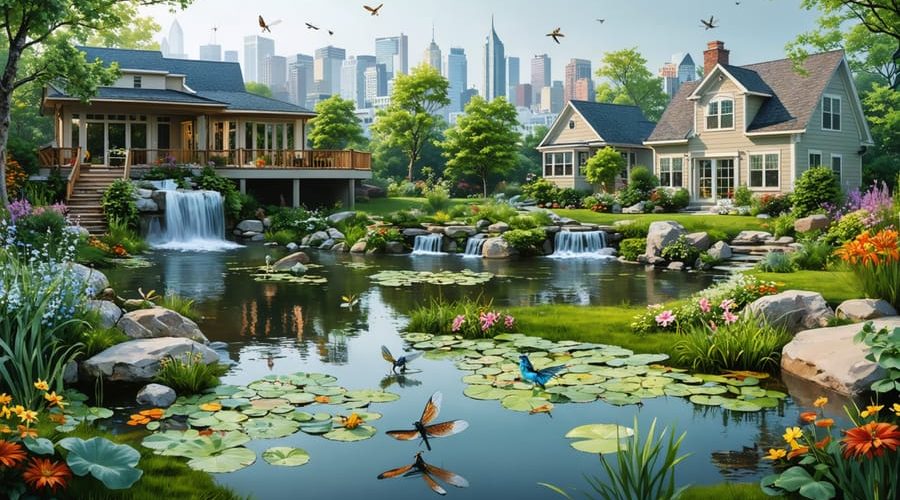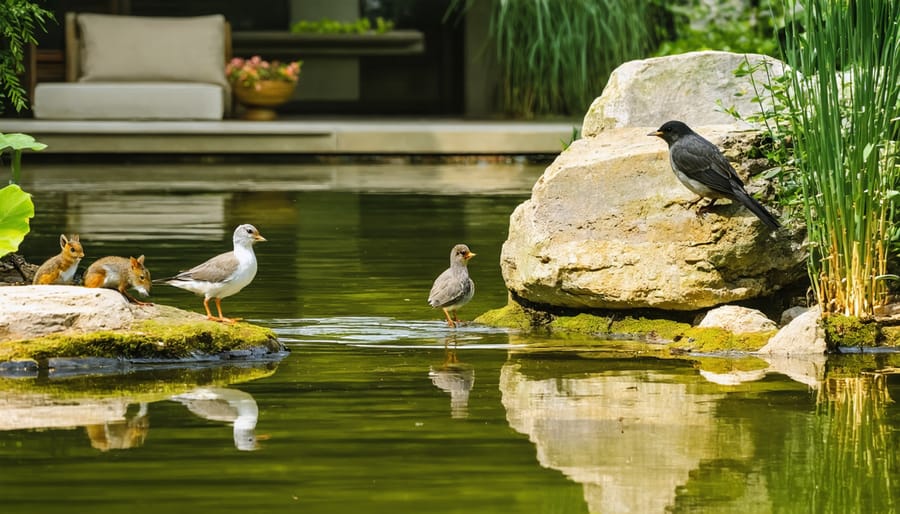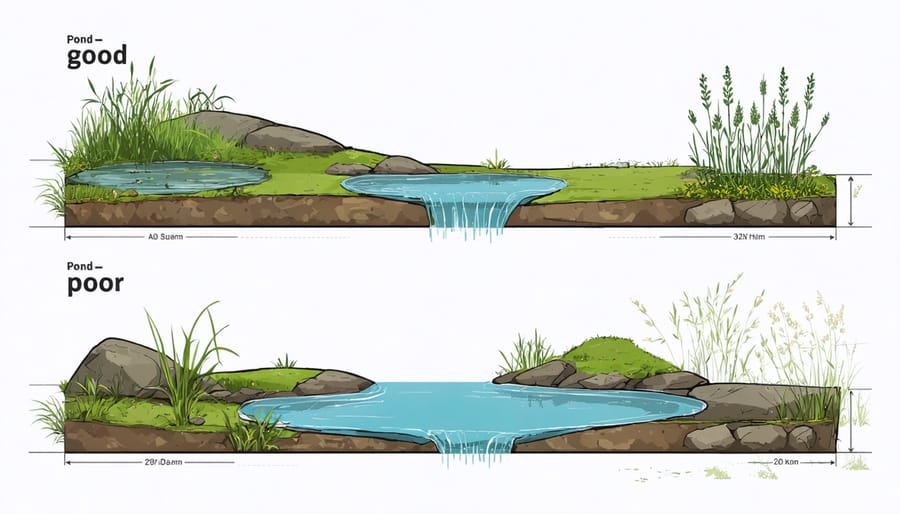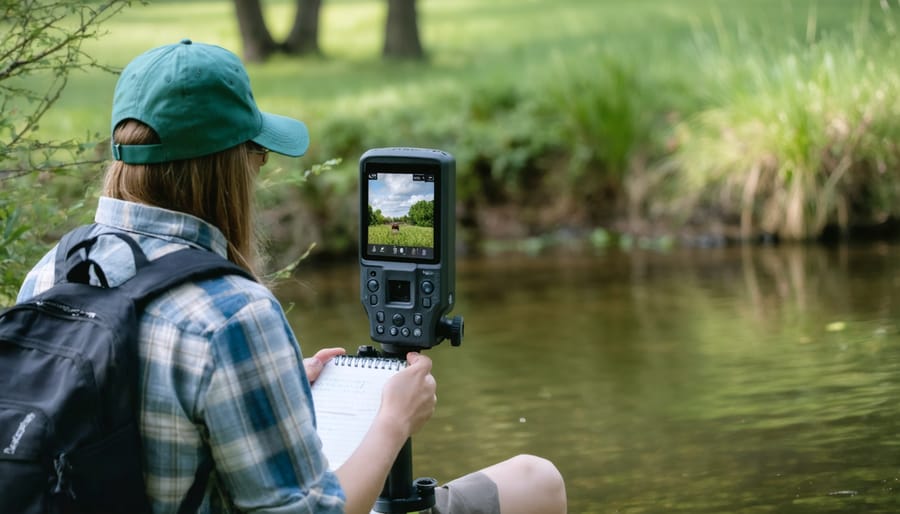
How Smart Cities Are Protecting Urban Wildlife (And Why Your Pond Matters)
In the heart of our bustling cities, a remarkable network of wildlife corridors and habitats is quietly thriving, connecting your backyard pond to a vast ecosystem of urban nature. The Urban Wildlife Information Network (UWIN) represents a groundbreaking collaboration between scientists, city planners, and homeowners like you who are transforming urban spaces into vibrant wildlife sanctuaries.
As pond owners and water gardening enthusiasts, we’re uniquely positioned to play a crucial role in this urban wildlife renaissance. Our water features serve as vital stepping stones in the urban wildlife corridor, providing essential resources for local fauna – from dragonflies and songbirds to beneficial amphibians and pollinators.
Understanding how your pond fits into this larger network isn’t just about conservation – it’s about creating a more resilient and beautiful garden space. Whether you’re maintaining a small container water garden or managing a larger backyard ecosystem, your efforts contribute to a city-wide tapestry of wildlife habitats that help maintain biodiversity in our increasingly urbanized world.
This growing movement of urban wildlife monitoring and habitat creation is revolutionizing how we think about city spaces, proving that concrete jungles can indeed become thriving ecosystems when we work together to create and maintain these crucial wildlife connections.
Urban Wildlife Networks: Connecting Your Pond to the Bigger Picture
The Role of Backyard Ponds in Urban Wildlife Conservation
Backyard ponds play a vital role in creating natural wildlife corridors within urban environments, offering essential habitat for various species. These water features serve as stepping stones between larger natural areas, providing drinking water, breeding grounds, and shelter for local wildlife. Birds, amphibians, beneficial insects, and even small mammals rely on these aquatic oases for survival in otherwise developed areas.
Even modest-sized ponds can make a significant impact on urban biodiversity. By incorporating native plants, shallow edges, and varying depths, pond owners create microhabitats that support different species. Dragonflies help control mosquito populations, while frogs and toads act as natural pest controllers in gardens. Water-loving birds bring color and song to urban spaces, enhancing the outdoor experience for residents.
The collective impact of backyard ponds creates a network of wildlife-friendly spaces throughout urban areas. When multiple homeowners maintain healthy pond ecosystems, they contribute to a larger system of urban wildlife support, helping ensure the survival of native species in our cities and suburbs.

Data Collection and Citizen Science
As a pond owner, you can play a vital role in urban wildlife research through citizen science. Your backyard water feature serves as a perfect observation point for collecting valuable data about local wildlife patterns and behaviors. Start by keeping a simple logbook to record wildlife sightings, noting the species, time of day, and behaviors you observe around your pond.
Many organizations now offer user-friendly mobile apps that make data collection a breeze. You can snap photos of visiting creatures and submit them directly to research databases. Whether it’s documenting frog calls, counting bird species, or tracking seasonal butterfly visitors, every observation helps build a clearer picture of urban wildlife movements.
Consider joining local wildlife monitoring programs or connecting with nearby nature centers that coordinate citizen science efforts. These organizations often provide training sessions and resources to help you identify species correctly and understand what information is most valuable to researchers.
Remember to maintain consistent observation times and methods to ensure your data is reliable. Even 15 minutes of daily wildlife watching can contribute meaningful information to urban ecology studies. Your pond isn’t just a beautiful feature – it’s a window into urban wildlife patterns that scientists need to understand.
Making Your Pond Wildlife-Friendly (While Protecting Your Fish)

Safe Access Points for Wildlife
Creating safe access points for wildlife in your pond doesn’t mean compromising the safety of your fish and plants. By implementing thoughtful design features, you can welcome beneficial creatures while deterring unwanted visitors. Start by creating gradual slopes or “wildlife ramps” using rocks or logs that extend from the water’s edge to deeper areas. These gentle inclines allow small animals like frogs, turtles, and beneficial insects to easily enter and exit the water.
Install partially submerged rocks or floating platforms around the pond’s perimeter to create resting spots for birds and amphibians. These features should be stable and positioned away from fish-heavy areas to measure pond biodiversity without disturbing your aquatic pets.
Consider adding shallow shelves or terraces along the pond’s edge, ranging from 2-4 inches deep. These areas provide safe drinking spots for local wildlife while keeping them away from deeper sections where valuable fish reside. Plant native vegetation around these access points to offer natural cover and create a more inviting environment for wildlife.
Remember to maintain clear sightlines around wildlife access points, ensuring predators can’t use them as hiding spots. Installing motion-activated sprinklers or lights near sensitive areas can help deter larger unwanted visitors while still allowing smaller beneficial creatures to safely access your pond.
Natural Barriers and Deterrents
Creating a wildlife-friendly environment doesn’t mean you have to accept unwanted visitors that might damage your garden or pond. There are several gentle ways to protect your pond from predators while maintaining an ecological balance.
Natural barriers like thorny shrubs or dense plantings can create effective boundaries that discourage larger animals from accessing sensitive areas. Consider planting raspberry bushes or native roses around your pond’s perimeter – they’re both beautiful and defensive. Strategic rock placement can also limit access points while enhancing your landscape’s natural appearance.
Motion-activated sprinklers offer a harmless but effective deterrent for most wildlife. These devices startle animals with a quick burst of water, teaching them to avoid the area without causing any harm. Similarly, reflective objects like old CDs or specialized reflection tape can create moving light patterns that make wildlife uneasy.
Aromatic deterrents work well for specific species. Mint, lavender, and citrus plants naturally repel many unwanted visitors while attracting beneficial insects. Coffee grounds scattered around garden edges can deter cats and other small mammals, while also enriching your soil.
Remember to maintain these barriers seasonally and adjust your strategy based on which wildlife species are most active in your area. The goal is to create gentle boundaries that guide wildlife to more appropriate habitats while protecting your garden sanctuary.
Monitoring and Managing Wildlife Activity
Simple Wildlife Tracking Methods
Tracking wildlife visits to your pond doesn’t require expensive equipment or complex technology. One of the simplest methods is to look for animal tracks in soft mud or sand around your pond’s edges. Create a tracking strip by maintaining a 2-foot-wide band of smooth, damp soil around parts of your pond. Check it each morning to discover who visited overnight.
Motion-activated trail cameras are another excellent option, becoming more affordable and user-friendly each year. Position them 3-4 feet off the ground, facing your pond but avoiding direct sunlight. These cameras can capture fascinating nighttime visitors you might never otherwise see.
Keep a wildlife journal to record your observations. Note the date, time, species, and any interesting behaviors you witness. Even simple smartphone photos can help document your visitors. Look for other signs like partially eaten plants, droppings, or feathers around your pond area.
Installing a basic infrared motion sensor light can alert you to nighttime visitors while also deterring unwanted guests. For bird watching, set up a comfortable observation spot where you can sit quietly without disturbing wildlife. Early morning and dusk are typically the best times for wildlife viewing.
Remember to maintain a safe distance and never approach or feed wild animals. Your role is to observe and document, allowing these creatures to behave naturally in their urban habitat.

When to Seek Professional Help
While urban wildlife can enrich our outdoor spaces, certain situations require professional intervention. Contact wildlife experts immediately if you observe animals showing signs of illness, such as disorientation, aggression, or unusual daytime activity in nocturnal species. Professional help is also necessary if you notice multiple dead animals in your area, as this could indicate disease outbreaks affecting local populations.
Seek assistance when wildlife causes structural damage to your property, creates unsafe conditions, or establishes nests in problematic locations like chimneys or attics. If you encounter injured animals, avoid handling them directly and contact licensed wildlife rehabilitators who have the proper training and permits to provide care.
For pond owners specifically, consult professionals if you notice significant changes in local wildlife patterns that might impact your water feature, such as excessive predation of fish or damage to aquatic plants. Wildlife management experts can help develop effective deterrent strategies that protect your investment while maintaining ecological balance.
Remember to document any wildlife concerns with photos and detailed notes about behavior patterns before contacting professionals. This information helps experts assess the situation accurately and propose appropriate solutions. Always work with licensed and certified wildlife professionals who follow local regulations and humane practices in their management approaches.
As we’ve explored throughout this article, urban wildlife networks play a vital role in maintaining the delicate balance between human development and natural ecosystems. Every pond, garden, and green space we create becomes a potential stepping stone for wildlife, contributing to the larger picture of urban biodiversity. By understanding and embracing our role as stewards of these urban habitats, we can make a meaningful difference in wildlife conservation right from our backyards.
Remember that successful wildlife interaction starts with responsible practices. Keep your pond and surrounding areas clean, avoid using harmful chemicals, and maintain appropriate boundaries with wild animals. Small actions, like installing wildlife-friendly features or creating natural corridors between water features, can have ripple effects throughout your local ecosystem.
Community involvement is equally crucial. Share your experiences with neighbors, join local conservation groups, or participate in citizen science projects that monitor urban wildlife. Your observations and data can contribute to better understanding and protecting urban animals.
As pond owners and gardening enthusiasts, we’re uniquely positioned to support urban wildlife networks. By maintaining our water features thoughtfully and sharing our knowledge with others, we create not just beautiful spaces for ourselves but vital sanctuaries for urban wildlife. Together, we can build stronger, more resilient communities where both humans and wildlife thrive side by side.
